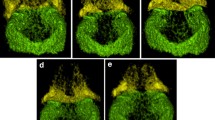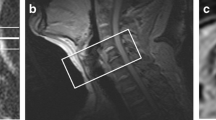Abstract
The paralyzed arytenoid is not immobile and is subjected to passive movement during phonation. If anatomical changes during inspiration and phonation are compared by three-dimensional computed tomography (3D CT), it is possible to observe vertical movement of the paralyzed arytenoid. Our aim was to use 3D CT to examine the characteristics of 3D arytenoid movement in unilateral vocal fold paralysis (UVFP). This is a prospective study. A total of 61 patients (18 females and 43 males) with UVFP who had undergone 3D CT imaging between April 2005 and January 2007 were included. Cricoid and arytenoid cartilage was imaged by 3D CT. We detected the movements of the paralyzed side when comparing inspiration and phonation. The degree of cranial displacement of the paralyzed arytenoids was classified into three grades (I for mild to III for severe). The mean flow rate (MFR) was calculated for each grade. By comparing the MFR of each grade with the normal control group, we determined whether cases would worsen according to grade. Passive gliding movement of the paralyzed arytenoids was found in 90.7% of cases. In all cases, the paralyzed arytenoids were displaced cranially compared to the unaffected side. MFR worsened significantly as the grade became more severe. We believe that the passive gliding movements observed when comparing inspiration and phonation are characteristic of paralysis. Even in mild cases, the paralyzed arytenoids are passively displaced cranially during phonation, and the degree of this displacement is one indicator that can be used to evaluate the severity of UVFP.




Similar content being viewed by others
References
Von Leden H, Moore P (1961) The mechanics of the cricoarytenoid joint. Arch Otolaryngol 73:63–72
Frable MA (1961) Computation of motion at the cricoarytenoid joint. Arch Otolaryngol 73:553–556
Maue WM, Dickson DR (1971) Cartilages and ligaments of the adult human larynx. Arch Otolaryngol 94:432–439
Sellars IE, Keen EN (1978) The anatomy and movements of the cricoarytenoid joint. Laryngoscope 88:667–674
Walshe P, Hamilton S, McShane D et al (2002) The potential of virtual laryngoscopy in the assessment of vocal cord lesions. Clin Otolaryngol Allied Sci 27:98–100
Yumoto E, Sanuki T, Hyodo M et al (1997) Three-dimensional endoscopic mode for observation of laryngeal structures by helical computed tomography. Laryngoscope 107:1530–1537
Meglin AJ, Biedlingmaier JF, Mirvis SE (1991) Three-dimensional computerized tomography in the evaluation of laryngeal injury. Laryngoscope 101:202–207
Fried MP, Moharir VM, Shinmoto H et al (1999) Virtual laryngoscopy. Ann Otol Rhinol Laryngol 108:221–226
Jun BC, Kim HT, Kim HS et al (2005) Clinical feasibility of the new technique of functional 3D laryngeal CT. Acta Otolaryngol 125:774–778
Hiramatsu H, Yamaguchi H, Niimi S et al (2004) An attempt for construction of precision three-dimensional laryngeal model (in Japanese). Nippon Jibiinkoka Gakkai Kaiho 107:945–955
Hiramatsu H, Tokashiki R, Yamaguchi H et al (2006) Three-dimensional laryngeal model for planning of laryngeal framework surgery. Acta Otolaryngol 126:515–520
Hiramatsu H, Tokashiki R, Suzuki S (2006) Three-dimensional computed tomography of the larynx and laryngeal model (in Japanese). Larynx Jpn 18:96–100
Hiramatsu H, Tokashiki R, Suzuki S (2007) Usefulness of three-dimensional computed tomography of the larynx for evaluation of unilateral vocal fold paralysis before and after treatment: technique and clinical applications. Eur Arch Otorhinolaryn [Epub ahead of print]
Hiroto I, Hirano M, Tomita H (1968) Electromyographic investigation of human vocal cord paralysis. Ann Otol Rhinol Laryngol 77:296–304
Crumley RL (2000) Laryngeal synkinesis revisited. Ann Otol Rhinol Laryngol 109:365–371
Tokashiki R, Hiramatsu H, Tsukahara K et al (2007) A new procedure of arytenoid adduction combined with type I thyroplasty under general anesthesia using a laryngeal mask. Acta Otolaryngol 127:328–331
Tokashiki R, Hiramnatsu H, Tsukahara K et al (2007) A “fenestration approach” for arytenoid adduction through the thyroid ala combined with type I thyroplasty. Laryngoscope 117:1882–1887
Author information
Authors and Affiliations
Corresponding author
Rights and permissions
About this article
Cite this article
Hiramatsu, H., Tokashiki, R., Nakamura, M. et al. Characterization of arytenoid vertical displacement in unilateral vocal fold paralysis by three-dimensional computed tomography. Eur Arch Otorhinolaryngol 266, 97–104 (2009). https://doi.org/10.1007/s00405-008-0682-0
Received:
Accepted:
Published:
Issue Date:
DOI: https://doi.org/10.1007/s00405-008-0682-0




